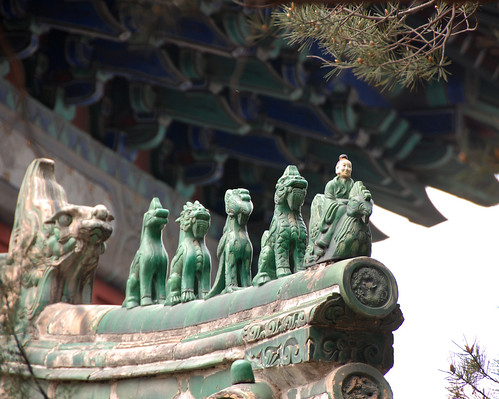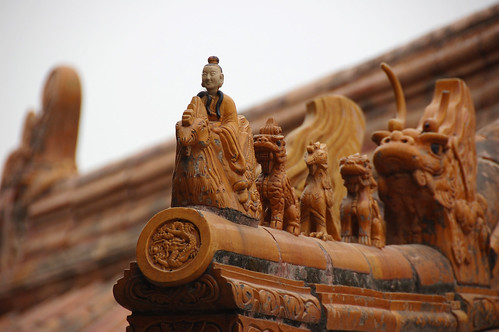Due to the semi-complexity of this topic, I decided to post some photos and explainations about the subject to give you a better understanding of these Roof Figures. Watch the video for your basic facts, and refer to here for supplemental info. Again, if there are any facts I miscorrectly stated, let me know what the error is, and I will fix that. Take advantage of the photos by clicking on them to get enlarged versions so that you can look at the details placed.
- Actual photos
- Graphics of Roof Figures + Explainations
- Symbolism
1) Actual photos (click to see enlarged version):
(Above; Forbidden City) Photo by avirus.

(Above; Summer Palace (Beijing, China) photos by Fang Chen)
Chen has the larger versions of those photos (and amazing photos of China) if you click on the photos.
Above; Forbidden City Photo by Saad.Akhtar.
(Will add more later, if possible)
2) Graphics of Roof Figures + Explainations
These are graphics I gathered from the ChinaHistoryForum website from a forum user who scanned these out of Chinese (I assume, textbooks). They were really difficult to find, and they helped utilized my research. For those who can read Chinese, this is useful for you. I don't have the specific textbook source, unfortunately. Click the photos for a better view.
The order of all of the roof figures goes like this, from left to right: Hen, Dragon, Phoenix, Lion, Celestial Horse, Seahorse, mythical lion (狻猊), wind-and storm-summoning fish (狎魚), courageous goat-bull (獬豸), 斗牛 evil-dispelling bull, and immortal guardian (行什, hangshi)
It's important to note that not every royal building in China has to have all these animals, but they must be in this specific order. The more roof figures, the higher the rank. The maximum amount, excluding the hen and the last guy on the right, must be nine.
According to what I read up, supposedly the last guy in the right is actually an immortal, due to its long ears. You can only find it in the Hall of Supreme Harmony in the Forbidden City in China.
3) Symbolism
I'll just mention the more prevalent animals and what they symbolize.
- The dragon, which is a yang (feng shui), is in charge of water. It is supposed to bring rain and water to the lands, especially in a country like China which relies heavily on farming. It is closely related to heaven, so you could think of it as being the gatekeeper of rain. The dragon is also a symbol of royalty, since Chinese culture believed in divine right of emperors.
- However, since this dragon is a qiwen, or the second son out of the nine descendants of the dragon, it is supposed to protect the structure against any fire hazards.
- The Phoenix, or Fenghuang, represents high virtue and grace. It is actually a combination of two birds – a male bird, feng, and a female bird, huang, but it closely looks like a peacock. It unites yin, feminine values, with yang, male values, which combines beauty and power together. It does not tolerate those who break the rules, and is a very kind being.
- The lion represents power, which is why it protects from evil spirits. You also see lions on imperial doorways, gates, temples, and tombs.











No comments:
Post a Comment